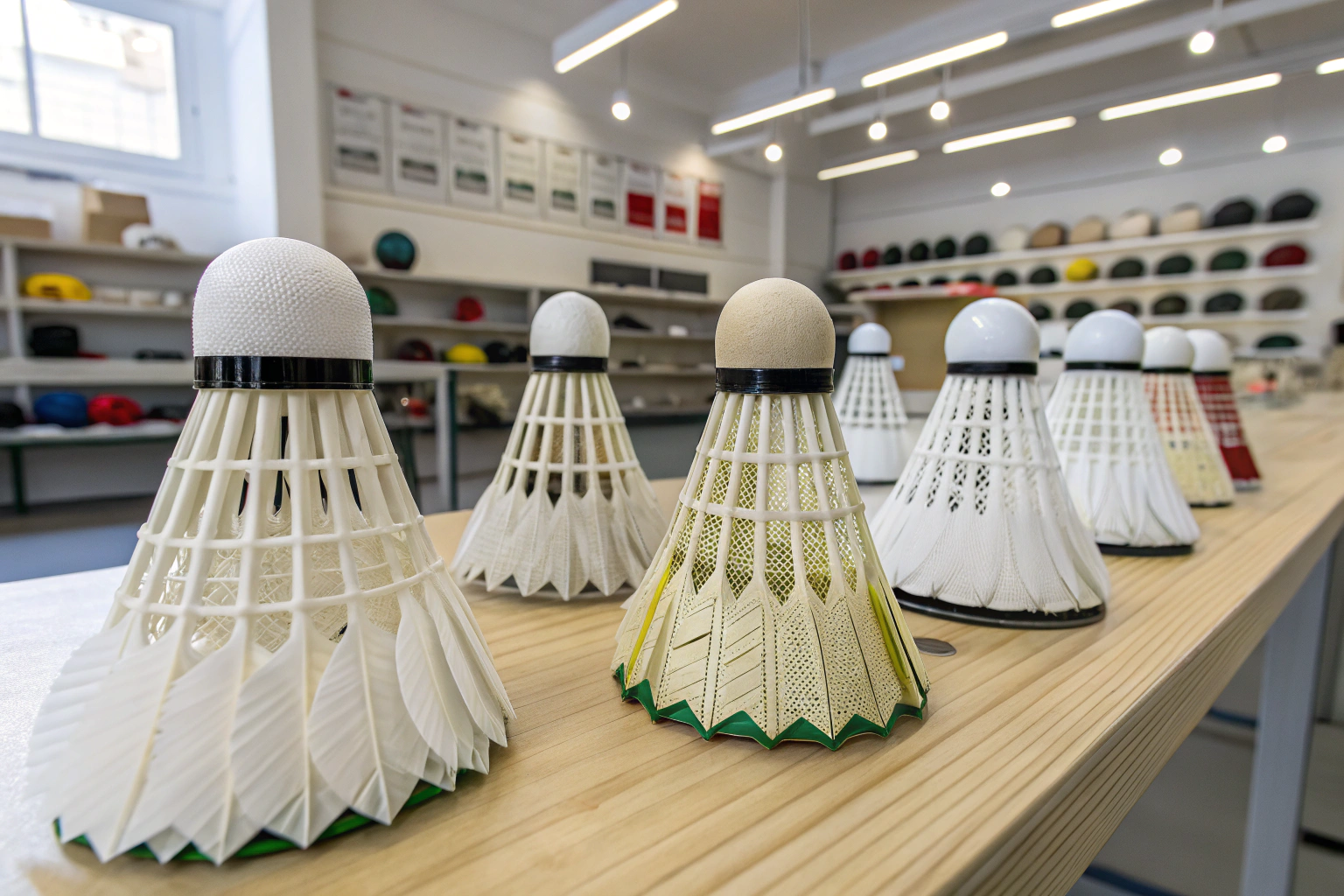Choosing the right shuttlecock is just as important as selecting the right racket. The shuttlecock’s performance can affect your game, whether you’re playing casually or in a competitive match. With various types of shuttlecocks available, it’s essential to understand the differences and choose the one that best suits your playing style.

In this guide, we will explore the types of shuttlecocks, their materials, and what factors to consider when choosing the right one for your game.
Selecting the right shuttlecock can impact your game significantly. Let’s dive into the factors that should guide your decision.
What Are the Different Types of Shuttlecocks?
Shuttlecocks come in two main types: feathered and nylon. The type you choose will depend on your playing conditions and preferences.
Feathered shuttlecocks are traditional and preferred for high-level play, while nylon shuttlecocks are more durable and affordable for recreational use.
-
Feathered Shuttlecocks: Made from real feathers (usually goose or duck), these shuttlecocks offer a more natural flight and are preferred in professional play. They provide a higher level of control and are sensitive to air conditions. Feathered shuttlecocks are generally more expensive and less durable than nylon ones.
-
Nylon Shuttlecocks: These are made from synthetic materials and are more durable, making them ideal for casual or recreational play. They are less affected by air resistance, but they don’t provide the same flight accuracy or control as feathered shuttlecocks.
What Should You Consider When Choosing Between Feathered and Nylon?
Choosing between feathered and nylon shuttlecocks depends largely on your playing level, budget, and where you plan to play.
Feathered shuttlecocks are better for professional play, while nylon shuttlecocks are great for beginners and casual players.
Feathered shuttlecocks offer a more authentic and controlled experience, especially if you’re playing in tournaments or serious matches. They provide a higher level of precision due to their flight characteristics and are suitable for indoor play in controlled environments. However, feathered shuttlecocks can break or wear out more quickly, which means they need to be replaced more often.
Nylon shuttlecocks, on the other hand, are ideal for beginners, children, and recreational players. They are incredibly durable and able to withstand multiple impacts without damage. While they may not offer the same control or flight quality as feathered shuttlecocks, they perform well in casual or outdoor settings, making them more affordable in the long run.
How Does the Weight of the Shuttlecock Affect Your Game?
The weight of the shuttlecock can influence how it flies, how it’s hit, and your overall control.
Heavier shuttlecocks provide more control, while lighter ones offer faster speeds.
Shuttlecocks are usually classified by their weight, with heavier ones providing more stability in flight, especially during longer rallies. A heavier shuttlecock is ideal for players who want to control the shuttle’s trajectory and speed with more precision. They are often used in competitive play where accuracy is key.
Lighter shuttlecocks, while faster, can be harder to control, particularly for beginners. They are often used in practice or casual games where fast, aggressive play is preferred.
What Are the Key Differences Between Indoor and Outdoor Shuttlecocks?
Shuttlecocks are designed specifically for indoor or outdoor play, and the differences are crucial depending on where you plan to play.
Indoor shuttlecocks are designed for controlled environments, while outdoor shuttlecocks are made to withstand wind and outdoor elements.
Indoor shuttlecocks are typically made with feathers and have a more accurate flight path. These are best used in controlled environments like gymnasiums or indoor courts. Feathered shuttlecocks are designed to perform well in wind-free settings, providing consistent flight and good control.
Outdoor shuttlecocks, however, are usually made from nylon and are designed to handle windy conditions. Their heavier construction helps them maintain flight stability outdoors, where wind can significantly affect a shuttlecock’s trajectory. These shuttlecocks are less affected by wind and are durable enough to withstand harsher conditions, but they may not offer the same control as indoor shuttlecocks.
What Should You Look for in a High-Quality Shuttlecock?
When shopping for a high-quality shuttlecock, you should consider factors like material, flight stability, and durability.
Look for shuttlecocks that offer good flight consistency, durability, and an appropriate level of control for your skill level.
- Flight Consistency: The shuttlecock should maintain a steady, predictable flight path. Feathered shuttlecocks are often preferred for their superior flight characteristics.
- Durability: Choose shuttlecocks that can withstand multiple games. Nylon shuttlecocks tend to last longer, but higher-quality feathered shuttlecocks can also provide excellent durability if used carefully.
- Skill Level: Beginners should look for durable and forgiving shuttlecocks (nylon), while more advanced players should focus on those that offer more control and a natural flight (feathered).
How Much Should You Spend on a Shuttlecock?
Shuttlecock prices vary depending on the material, quality, and brand.
Nylon shuttlecocks are generally cheaper, while feathered shuttlecocks are more expensive due to the materials used.
Nylon shuttlecocks are typically more affordable, with a pack of 6 or 12 often costing less than $20. These are great for practice, beginners, or casual players. Feathered shuttlecocks, on the other hand, are pricier due to the materials (often goose or duck feathers) and manufacturing process. Prices can range from $20 to $50 or more for high-quality feathered shuttlecocks. Competitive players tend to invest more in feathered shuttlecocks for better performance and flight characteristics.
Conclusion
Choosing the right shuttlecock depends on several factors including your playing environment, skill level, and budget. Feathered shuttlecocks provide better performance and control for serious play, while nylon shuttlecocks are durable and cost-effective for casual games. By understanding the different types, materials, and prices, you can make a more informed decision that will enhance your game.